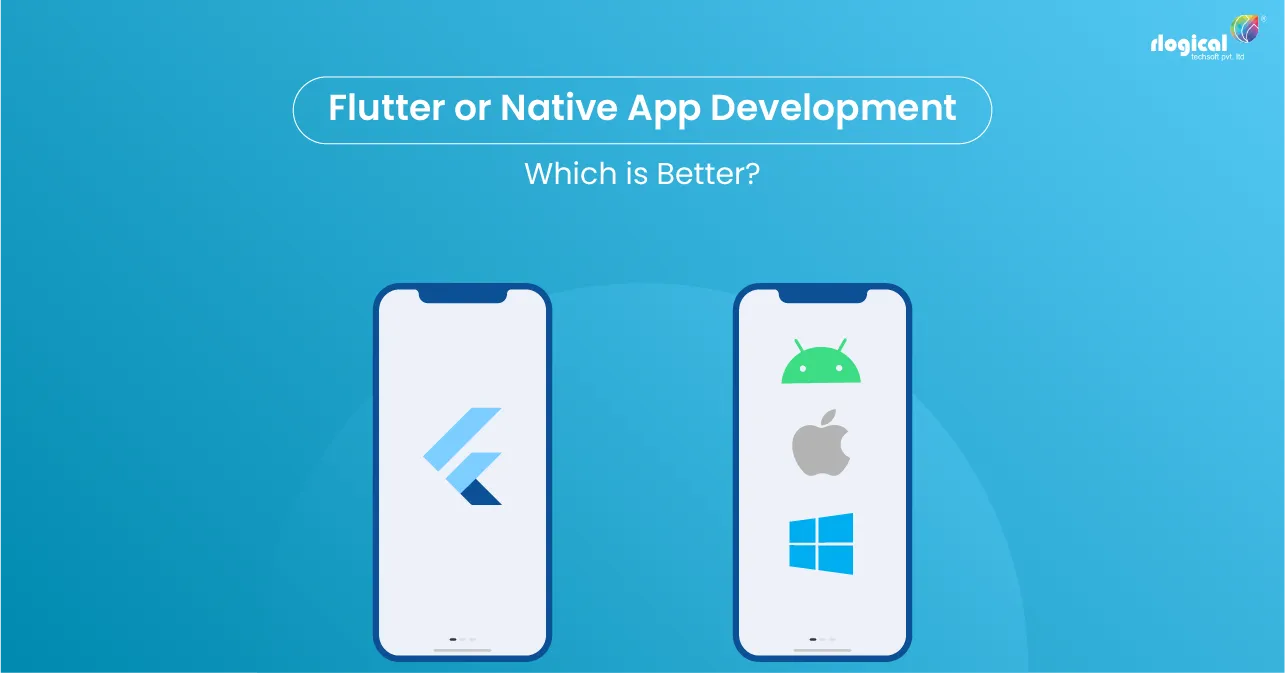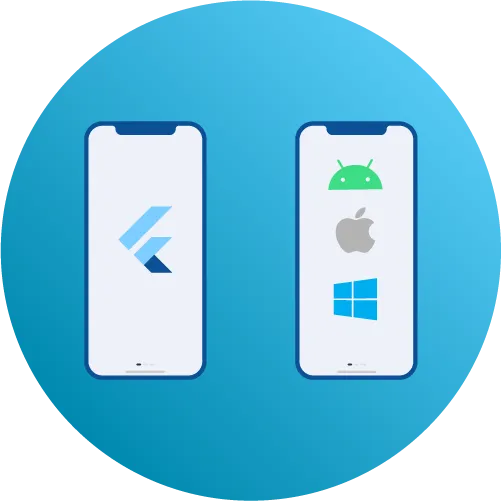
Developers are leveraging native technologies to build mobile apps on two prominent platforms that are Android and iOS. However, cross-platform frameworks like Flutter are gaining the interest of several businesses as the development of native apps is expensive. Enterprises are opting for Flutter app development services as it save their cost and development time. Cross-platform apps provide the same native-like performance for both platforms with one codebase.
You might get confused about whether it is better to go for one app applicable for both mobile platforms or develop two individual apps with separate codebases. For making the right decision, a detailed comparison includes performance, use cases, development costs, and much more. So, let’s dive into the blog to understand when to select Native or Flutter technology for app development.
Flutter Overview
Flutter is one of the popular cross-platform frameworks containing a toolset that enables developers to build an app for Android and iOS. Google released the framework back in 2018, and it operates using the programming language named Dart. It is an advanced UI toolkit that is used to create apps with just one codebase. With Flutter, intuitive and expressive UI can be developed with native-like performance. It facilitates smooth animations as well as great interface elements. Moreover, it has a strong Flutter community that supports the developers.
Native Technologies Overview
It is different from cross-platform frameworks. Native mobile app development is specific to either iOS or Android. These technologies leverage device features like a camera, compass, GPS, accelerometer, etc. The apps created from these technologies are installed via application stores like App Store and Google Play.
Native apps development need significant investments as the developers work a lot in adjusting interface, business logic, and features layout for each platform. Some popular programming languages and frameworks of native technologies are Swift, Xcode, Objective-c for iOS and Kotlin, Android Studio, Java for Android.
Read Also: Major Pros and Cons of Native App Development
Comparison Between Native and Flutter App Development
1. Development Cost and Speed
In native technologies, the speed or time needed to create mobile apps varies depending on the timeline, scaling, and budget capacity. For developing apps for both platforms, you will need two separate development teams or a large team that can do everything. Here, programmers have to write two codes for each platform having several functionalities. Thus, the cost will be more.
Flutter framework follows the write once and run everywhere approach and eases the task of developers by allowing them to write a single codebase for both platforms. It implies that the development time will be way shorter than native mobile app development. The cost of development will also be less as it does not require a big team. It not just enables developers to write code easily but also makes understanding these codes easier. The training costs of developers are less, and the necessity of multiple developers eliminates.
2. Application Size
For understanding the size of Native apps, here is an example. Suppose there is a ‘hello world’ app. Then the Android app size can be around 550 KB, and the iOS app size will be less than 3 MB. In native technologies, the app sizes can range between 15 MB to 35 MB. The usage of third-party tools can reduce the size even more.
In Flutter, the same ‘hello world’ app will be around 7.5 MB. App size in Flutters impacted by the C/C++ and Dart’s Virtual Machine. But Flutter can self-contain codes for avoiding size concerns. Through special tags such as –split-debug-info, the code size can be decreased.
3. Features and Integrations
The integration capacities of native technologies for both platforms through programming languages and frameworks vary depending on the app performance and design pattern. Native frameworks like Swift are used to create iOS apps and deliver excellent safety. It provides advanced features having faster integration capabilities. Java and Kotlin for Android provide a seamless integration capacity through its Intellij environment or runtime classes.
Integration capabilities of plugins or third-party libraries features are not that difficult using Flutter. But it can be difficult for developers who have less knowledge on the functionality of Dart. Features integration for Android and iOS needs add-on plugins such as Android Archive, Cocoa Pods, and many more.
However, the Flutter engine has limitations in integrating native modules through Xcode. The documentation offers manual interactions to eliminate these hurdles, and integrating with both platforms becomes possible. This increases the time-to-market. With the latest version release, Flutter updates to provide more support to the platforms.
Read Also: Google’s Flutter SDK – Is it Good Choice for Your App?
4. App Performance
As the functionalities of native performance are amazing, both platform apps perform well without needing external library tools. Native apps work excellent at 60 to 120 FPS, and the apps having core animations also work well. The maximum usage of GPU in native technologies ranges from 30 to 40% of total GPU performance.
Flutter framework does not need any bridge for communication between native modules. It performs well at 60 FPS. The framework utilizes Skia graphics that enables changes in UI when there are any changes in the app view.
5. Use Cases
Native technologies are used for animation-rich apps, AR/VR apps, gaming apps, complex UI apps, traveling-related apps, IoT apps, heavy-computation apps, and AI apps.
With Flutter app development, you can create material design apps, Build MVP apps, Flexible UI and top-notch widgets, high-performance apps, and reactivate apps.
6. Decision Making
You can opt for native technologies if you want to create high-performance apps connecting between device and app. You can take advantage of the complete device hardware, and updating apps on the new operating system is also easier. Native apps can have simple features that are reliable and provide excellent performance.
Flutter mobile apps can be created using one codebase, which saves time and cost. If you want to have a smoother design experience, then Flutter is best. You can build MVP apps having reactive widgets. With Flutter, the time-to-market decreases, and the app can reach a larger audience quickly.
Conclusion
Both Flutter and native technologies have their benefits, and selecting the right one depends on various factors like business requirements, cost, project needs, etc. Native technologies are ideal for simple niche apps with features like rich animation. Flutter is great if you want the development to be quicker at less cost. From the above comparison, analyze and decide which one will be the best for you.
Jatin Panchal
Jatin Panchal is the Founder & Managing Director at Rlogical Techsoft Pvt. Ltd. For more than a decade, he has been fostering the organization's growth in the IT horizons. He has always bestowed personalized approaches on .NET, PHP, Flutter, and Full-Stack web development projects. From startups to large enterprises, he has empowered them to accomplish business goals. By delivering successful industry-driven solutions, he is encouraging the capability of AI, ML, blockchain, and IoT into custom websites and hybrid mobile applications.
Related Blog
- Flutter for Web App Development: The Cross-Platform Companion For Your Business
- Flutter for Automotive App Development: The Secret Sauce for BMW & Toyota’s Success
- Why is Flutter a One-Stop Solution for Various Industries' App Development?
- Top 17+ Apps Built With Flutter to Enhance User Experience
- Why Use Flutter? Scope Of Flutter for Mobile App Development
Categories
- All
- AI Development Services
- Amazon Web Services (AWS)
- ASP.Net Development
- Azure Web App
- Big Data Analytic
- Customize
- Digital Marketing
- Drupal Development
- E-commerce web development
- Education Mobile App Development
- Enterprise Application
- Event Management App Development
- Fintech
- Fitness App Development
- Food Delievery
- Front-End Development
- Healthcare App Development
- Hire Dedicated Developers
- Hotel Booking App
- IT Industry
- JavaScript Development
- Mobile App Development
- On Demand App Development
- On Demand Healthcare App Development
- PHP Development
- POS Software Development
- Real Estate Mobile App Development
- Retail Business App Development
- Salesforce
- Social Media Development
- Software Development
- Technology
- Transportation App Development
- UI/UX Design
- Web Design
- Web Development
- Web Services
- Web/Data Scraping Services
- WordPress




 Jatin Panchal in Flutter App Development
Jatin Panchal in Flutter App Development 





